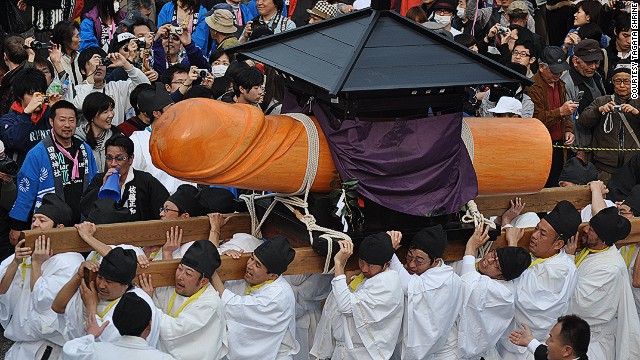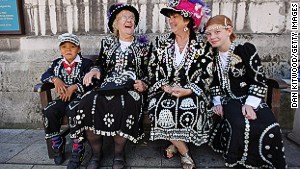Thanksgiving isn't the only colorful harvest festival...
November 29, 2013 -- Updated 1541 GMT (2341 HKT)
STORY HIGHLIGHTS
- In Komaki, Japan, Shinto priests try for a strong harvest by blessing a 600-pound wooden penis
- London's harvest festival is manned by the Pearly Kings and Queens -- who wear suits embroidered with pearl buttons
- Barbados celebrates the end of the sugar harvest with a giant party, and Calypso sing-off
(CNN) -- There are all sorts of ways to celebrate a successful harvest. In U.S. of course, people commemorate the season's bounty by giving thanks, overdosing on roast turkey, and turning on the TV to watch an endless parade of cartoon characters float about the streets of New York.
But today's Thanksgiving is not the only harvest festival on the cultural calendar. No matter the time of year, or place, a bounty of vegetables is often all it takes to get people singing, dancing, cow racing -- even parading around giant phalluses. To get in the spirit, we've reaped some of the world's most vibrant harvest festivals.
A team of men -- all aged 42 -- take turns carrying a 600-pound wooden phallus.
Honen Matsuri, Japan
To some, a procession led by a 600-pound wooden penis may seem a strange way to welcome the Spring, but in the small town ofKomaki, it's only natural. Honen Matsuri, or the fertility festival, is held every year on March 15, and while the plethora of phalluses on display have made the event a popular go-to for tittering tourists, it is actually a Shinto ritual meant to ensure a bountiful harvest in the coming months.
The main phallus is carved from a single cedar tree in the winter and brought to the local Tagata Shrine for purification. During the festival, it is paraded by a troupe of Shinto priests. In the lead-up to the main event, stalls serve up unending cups of saki to the crowd, and vendors hawk penis-shaped candies. The celebration ends with priests throwing out handfuls of mochi, or rice cakes, to anyone gathered in the shrine's courtyard -- a practice meant to bring good luck for the following year.
London's second royal family, the Pearly Kings and Queens are the mascots of the Harvest Festival.
Costermonger's Harvest Festival,England
For 125 years, the London harvest festival has had a troupe of shimmering mascots.The Pearly Kings and Queens -- deemed Britain's "second royal family" -- are renown for their dark suits emblazoned with hundreds of mother-of-pearl buttons, a tradition started by Henry Croft, an orphan-turned-street sweeper. He first got the idea from costermongers, or street hawkers, who used to line the seams of their pants with pearl buttons found on the street. He took it a step further and coated his whole suit -- top hat and all. Naturally, it wasn't long before he was a popular London fixture; he used his notoriety to raise money for various charities.
Each borough of London has its own Pearly Kind and Queen, and as a whole, the group functions mainly as a charitable organization. According to Doreen Golding, the Pearly Queen of Old Kent Road and Bow Bells, charity and harvest go hand-in-hand.
"It doesn't matter what faith you are. At the end of the year, when all the crops are gathered and have been given to people in the community, it's typical to then give them out to all the homeless people who haven't got any food," she says. Like Croft, the "Pearlies" use their fame to fund raise.
No more sugar? In Barbados, that means it's time to party.
Crop Over, Barbados
In 1780, Barbados was one of the biggest sugar producers in the world. Today, that honor goes to Brazil, but the Caribbean country still celebrates the sugar harvest with a month-long festival in July, known as Crop Over.
Pic-O-De Crop -- a kind of "American Idol" for Calypso music -- is one of the festival's most popular events, where finalists are judged for their savvy lyrics, content, melody and diction. LikeBrazil's Carnival, the costumes help make the event (that, and copious amounts of rum), and prizes are given out for the most outrageous concoctions at the festival's end.
In Greek Orthodox communities, the prelude to the harvest coincides with a staple on the religious calendar -- Epiphany Day(January 6). To celebrate the baptism of Christ, and to curry blessing for the coming season, the local bishop leads a procession to the nearest body of water, where he tosses a crucifix into the sea. Volunteers (mainly young men) leap in after it and compete to be the first to catch it. Whoever rescues the cross from the sea will supposedly be granted good luck in the upcoming year. After the waters are blessed, some folks wash their produce in the harbor in hopes of a bountiful Autumn harvest.
Rice Harvest, Indonesia
In West Sumatra, Minangkabau farmers have found a particularly daredevil means of celebrating the end of the rice season; they cow surf. Riding a wooden plank, and grasping the tails of two harnessed bulls, these farmer-turned-jockeys careen through the mud as part of the centuries-old sport of Pacu Jawi. The tradition is meant to show the strength of the bulls, many of which are later sold at auction.

 In the Japanese town of Komaki, the Autumn bounty is preceded by Honen Matsuri -- or the fertility festival. Shinto priests bless a massive wooden phallus, which they offer to the gods in exchange for a fruitful season.
In the Japanese town of Komaki, the Autumn bounty is preceded by Honen Matsuri -- or the fertility festival. Shinto priests bless a massive wooden phallus, which they offer to the gods in exchange for a fruitful season.


ไม่มีความคิดเห็น:
แสดงความคิดเห็น